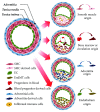Plant-Derived Products for Treatment of Vascular Intima Hyperplasia Selectively Inhibit Vascular Smooth Muscle Cell Functions
- PMID: 30405738
- PMCID: PMC6201497
- DOI: 10.1155/2018/3549312
Plant-Derived Products for Treatment of Vascular Intima Hyperplasia Selectively Inhibit Vascular Smooth Muscle Cell Functions
Abstract
Natural products are used widely for preventing intimal hyperplasia (IH), a common cardiovascular disease. Four different cells initiate and progress IH, namely, vascular smooth muscle, adventitial and endothelial cells, and circulation or bone marrow-derived cells. Vascular smooth muscle cells (VSMCs) play a critical role in initiation and development of intimal thickening and formation of neointimal hyperplasia. In this review, we describe the different originating cells involved in vascular IH and emphasize the effect of different natural products on inhibiting abnormal cellular functions, such as VSMC proliferation and migration. We further present a classification for the different natural products like phenols, flavonoids, terpenes, and alkaloids that suppress VSMC growth. Abnormal VSMC physiology involves disturbance in MAPKs, PI3K/AKT, JAK-STAT, FAK, and NF-κB signal pathways. Most of the natural isolate studies have revealed G1/S phase of cell cycle arrest, decreased ROS production, induced cell apoptosis, restrained migration, and downregulated collagen deposition. It is necessary to screen optimal drugs from natural sources that preferentially inhibit VSMC rather than vascular endothelial cell growth to prevent early IH, restenosis following graft implantation, and atherosclerotic diseases.
Figures




Similar articles
-
Molecular Action of Hydroxytyrosol in Attenuation of Intimal Hyperplasia: A Scoping Review.Front Pharmacol. 2021 May 21;12:663266. doi: 10.3389/fphar.2021.663266. eCollection 2021. Front Pharmacol. 2021. PMID: 34093194 Free PMC article.
-
Overexpression of the focal adhesion kinase (p125FAK) in the vascular smooth muscle cells of intimal hyperplasia.J Vasc Surg. 2001 Aug;34(2):344-9. doi: 10.1067/mva.2001.114814. J Vasc Surg. 2001. PMID: 11496289
-
CD36 Enhances Vascular Smooth Muscle Cell Proliferation and Development of Neointimal Hyperplasia.Arterioscler Thromb Vasc Biol. 2019 Feb;39(2):263-275. doi: 10.1161/ATVBAHA.118.312186. Arterioscler Thromb Vasc Biol. 2019. PMID: 30567481 Free PMC article.
-
PPARγ Inhibits VSMC Proliferation and Migration via Attenuating Oxidative Stress through Upregulating UCP2.PLoS One. 2016 May 4;11(5):e0154720. doi: 10.1371/journal.pone.0154720. eCollection 2016. PLoS One. 2016. PMID: 27144886 Free PMC article.
-
Statin-induced vascular smooth muscle cell apoptosis: a possible role in the prevention of restenosis?Curr Drug Targets Cardiovasc Haematol Disord. 2005 Apr;5(2):135-44. doi: 10.2174/1568006043586134. Curr Drug Targets Cardiovasc Haematol Disord. 2005. PMID: 15853755 Review.
Cited by
-
The Effects of Pro-Inflammatory and Anti-Inflammatory Agents for the Suppression of Intimal Hyperplasia: An Evidence-Based Review.Int J Environ Res Public Health. 2020 Oct 26;17(21):7825. doi: 10.3390/ijerph17217825. Int J Environ Res Public Health. 2020. PMID: 33114632 Free PMC article. Review.
-
Inhibition of ERK or Akt ameliorates intimal hyperplasia via up-regulation of Cx37 and down-regulation of Cx43 in balloon injury rat model.Cardiovasc Diagn Ther. 2020 Aug;10(4):658-666. doi: 10.21037/cdt-20-345. Cardiovasc Diagn Ther. 2020. PMID: 32968622 Free PMC article.
-
Molecular Action of Hydroxytyrosol in Attenuation of Intimal Hyperplasia: A Scoping Review.Front Pharmacol. 2021 May 21;12:663266. doi: 10.3389/fphar.2021.663266. eCollection 2021. Front Pharmacol. 2021. PMID: 34093194 Free PMC article.
-
YBX1 Modulates Intimal Hyperplasia by Regulating Expression and Alternative Splicing of Cell Cycle Associated Genes in RASMCs.J Cell Mol Med. 2025 Mar;29(5):e70445. doi: 10.1111/jcmm.70445. J Cell Mol Med. 2025. PMID: 40045484 Free PMC article.
-
Fhl1, a new spatially specific protein, regulates vein graft neointimal hyperplasia.Clin Transl Med. 2024 Dec;14(12):e70115. doi: 10.1002/ctm2.70115. Clin Transl Med. 2024. PMID: 39639552 Free PMC article.
References
-
- Kipshidze N., Dangas G., Tsapenko M., et al. Role of the endothelium in modulating neointimal formation: vasculoprotective approaches to attenuate restenosis after percutaneous coronary interventions. Journal of the American College of Cardiology. 2004;44(4):733–739. doi: 10.1016/j.jacc.2004.04.048. - DOI - PubMed
Publication types
LinkOut - more resources
Full Text Sources
Miscellaneous

